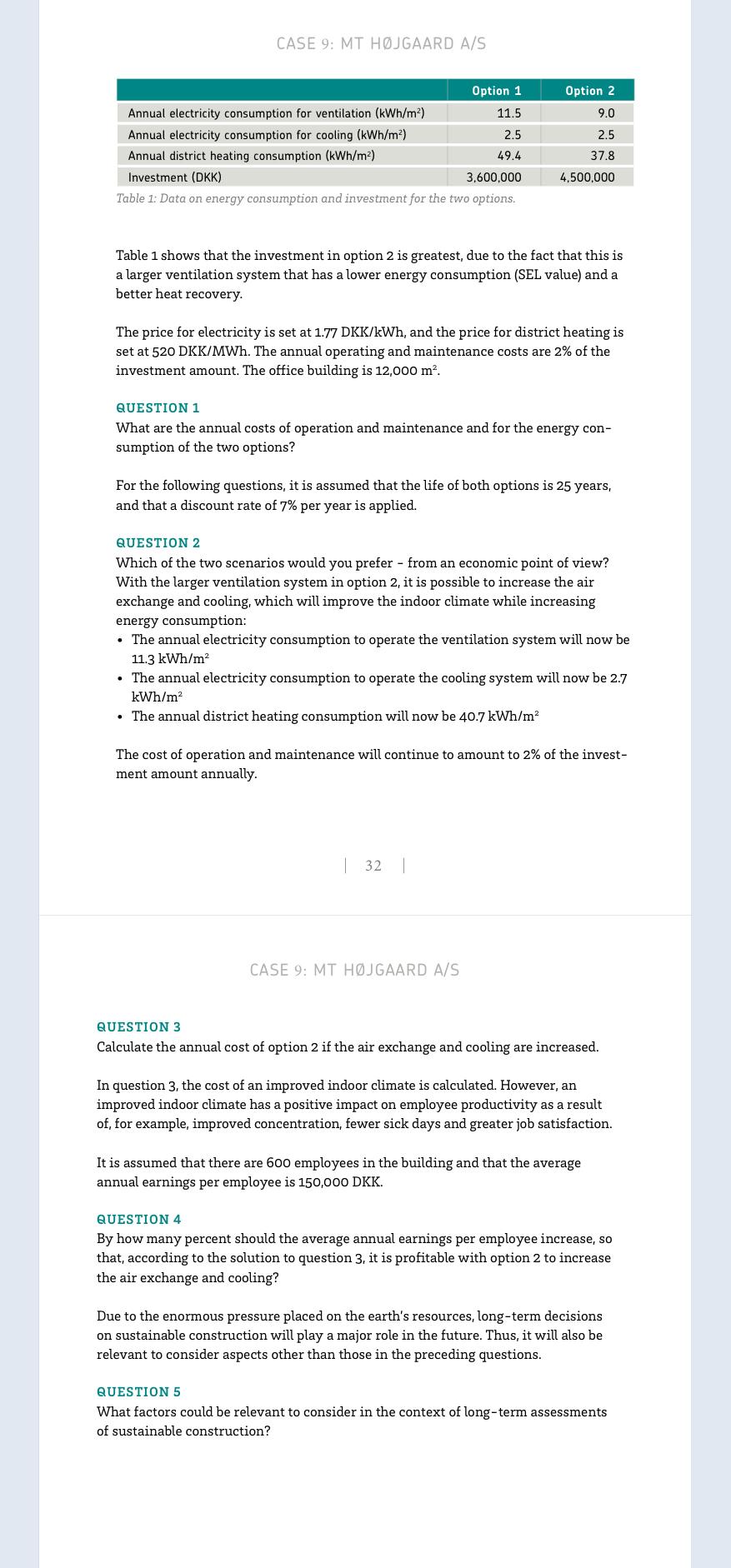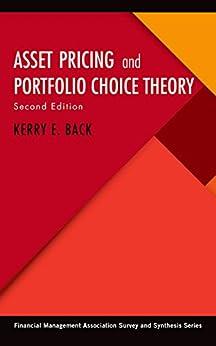
CASE 9: MT HJGAARD A/S Option 1 Annual electricity consumption for ventilation (kWh/m) 11.5 Annual electricity consumption for cooling (kWh/m) 2.5 Annual district heating consumption (kWh/m2) 49.4 Investment (DKK) 3,600,000 Table 1: Data on energy consumption and investment for the two options. Option 2 9.0 2.5 37.8 4,500,000 Table 1 shows that the investment in option 2 is greatest, due to the fact that this is a larger ventilation system that has a lower energy consumption (SEL value) and a better heat recovery. The price for electricity is set at 1.77 DKK/kWh, and the price for district heating is set at 520 DKK/MWh. The annual operating and maintenance costs are 2% of the investment amount. The office building is 12,000 m. QUESTION 1 What are the annual costs of operation and maintenance and for the energy con- sumption of the two options? For the following questions, it is assumed that the life of both options is 25 years, and that a discount rate of 7% per year is applied. QUESTION 2 Which of the two scenarios would you prefer - from an economic point of view? With the larger ventilation system in option 2, it is possible to increase the air exchange and cooling, which will improve the indoor climate while increasing energy consumption: The annual electricity consumption to operate the ventilation system will now be 11.3 kWh/m2 The annual electricity consumption to operate the cooling system will now be 2.7 kWh/m2 The annual district heating consumption will now be 40.7 kWh/m The cost of operation and maintenance will continue to amount to 2% of the invest- ment amount annually. | 32 | CASE 9: MT HJGAARD A/S QUESTION 3 Calculate the annual cost of option 2 if the air exchange and cooling are increased. In question 3, the cost of an improved indoor climate is calculated. However, an improved indoor climate has a positive impact on employee productivity as a result of, for example, improved concentration, fewer sick days and greater job satisfaction. It is assumed that there are 600 employees in the building and that the average annual earnings per employee is 150,000 DKK. QUESTION 4 By how many percent should the average annual earnings per employee increase, so that, according to the solution to question 3, it is profitable with option 2 to increase the air exchange and cooling? Due to the enormous pressure placed on the earth's resources, long-term decisions on sustainable construction will play a major role in the future. Thus, it will also be relevant to consider aspects other than those in the preceding questions. QUESTION 5 What factors could be relevant to consider in the context of long-term assessments of sustainable construction? CASE 9: MT HJGAARD A/S Option 1 Annual electricity consumption for ventilation (kWh/m) 11.5 Annual electricity consumption for cooling (kWh/m) 2.5 Annual district heating consumption (kWh/m2) 49.4 Investment (DKK) 3,600,000 Table 1: Data on energy consumption and investment for the two options. Option 2 9.0 2.5 37.8 4,500,000 Table 1 shows that the investment in option 2 is greatest, due to the fact that this is a larger ventilation system that has a lower energy consumption (SEL value) and a better heat recovery. The price for electricity is set at 1.77 DKK/kWh, and the price for district heating is set at 520 DKK/MWh. The annual operating and maintenance costs are 2% of the investment amount. The office building is 12,000 m. QUESTION 1 What are the annual costs of operation and maintenance and for the energy con- sumption of the two options? For the following questions, it is assumed that the life of both options is 25 years, and that a discount rate of 7% per year is applied. QUESTION 2 Which of the two scenarios would you prefer - from an economic point of view? With the larger ventilation system in option 2, it is possible to increase the air exchange and cooling, which will improve the indoor climate while increasing energy consumption: The annual electricity consumption to operate the ventilation system will now be 11.3 kWh/m2 The annual electricity consumption to operate the cooling system will now be 2.7 kWh/m2 The annual district heating consumption will now be 40.7 kWh/m The cost of operation and maintenance will continue to amount to 2% of the invest- ment amount annually. | 32 | CASE 9: MT HJGAARD A/S QUESTION 3 Calculate the annual cost of option 2 if the air exchange and cooling are increased. In question 3, the cost of an improved indoor climate is calculated. However, an improved indoor climate has a positive impact on employee productivity as a result of, for example, improved concentration, fewer sick days and greater job satisfaction. It is assumed that there are 600 employees in the building and that the average annual earnings per employee is 150,000 DKK. QUESTION 4 By how many percent should the average annual earnings per employee increase, so that, according to the solution to question 3, it is profitable with option 2 to increase the air exchange and cooling? Due to the enormous pressure placed on the earth's resources, long-term decisions on sustainable construction will play a major role in the future. Thus, it will also be relevant to consider aspects other than those in the preceding questions. QUESTION 5 What factors could be relevant to consider in the context of long-term assessments of sustainable construction







